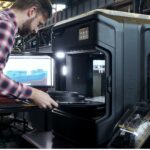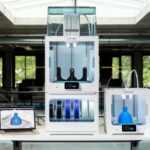V-Ray for 3ds Max
V-Ray for 3ds Max is the core development of Chaos Group, which allows users to quickly and easily create realistic images while giving them full control over the 3D production process
Kirk Shintani
Head of 3D, a52
This is, by far, the most substantial upgrade for our rendering pipeline since we switched to V-Ray 5 years ago. The “beta” was stable and amazingly fast, and the staff reaction to 3.0 is summed up with one word, “Whoa.” It’s that kind of fast. It allows us to stay focused on making cool imagery. That’s why we do what we do, isn’t it?
Tom Hankins
Creative Director, Colorbleed Studios
At Colorbleed Studios we’ve been using V-Ray since our start up in 2012. We work with Maya and in the past we have experimented with different renderers, but I always looked back at my 3dsmax and V-Ray days, so we were very excited once V-Ray for Maya came out. We all like how we can get nice renders without too much effort, for previewing and setup purposes and even for our NPR productions V-Ray has proven itself with its agility, power and speed. I especially enjoy the simplicity of using presets and the choice of all of the render elements. We use it on a daily basis from our largest to our super tiny productions. As the studio’s lighter and compositer I can not do my job these days without the power of V-Ray.
Dmitry Vinnik
CG Supervisor, Silhouette Images
When I first worked with V-Ray back in 2002, I was really struck down by how simple yet efficient V-Ray was. I could not believe the speed, quality and ease of setup in comparison to other renderers of that time. Since then V-Ray has become a number one choice for me in production as well as personal work.
Chris Christodoulou
CEO/ Managing Director, Saddington Baynes
We’ve experimented with several renderers over the years and each one does different things; but we’ve found that V-Ray has really been helping us on the more complex projects we’ve had recently which involve high-resolution, high-volume imagery that needs complete photographic reality, and that’s very important for us.
Alex Huguet
Senior 3D Artist, The Mill
I’ve loved V-Ray ever since the beginning, and I think it is the only software I’ve used that has never disappointed me and it has always performed perfectly. It is the best renderer I’ve used, and I always recommend it to everyone I have the chance to.
Esdras Varagnolo
Lighting Technical Director
www.gnolo.com
This is the first time I sit down with a rendering engine and the results, right out of the gate, are just right. It’s ease of use, really good integration with Maya, physical camera and RT not only allow you to focus on what’s important– being creative and finishing the work – but does this with great quality and speed. I am looking forward to keep working on V-Ray for my personal projects!
Jeremy Sahlman
Associate Creative Director
Buck LA, USA
BUCK has been using V-Ray for Maya since beta. Now we are almost exclusively a V-Ray shop. We consistently spend less time to achieve a higher quality product and it takes less time to train artists because of V-Ray ease of use. To push that relationship even further BUCK has been using real time rendering since its early implementation. It gives us almost real-time interactivity with lights and shaders. This ability has made it easy for our directors to sit down with an artist and truly direct lighting on a shot by shot basis. Last but not least our customer support has been nothing short of outstanding. No other company truly takes the input of their clients as seriously as the V-Ray team. It is not uncommon for use to make a feature request, or report a bug, and have 2 or 3 responses back within the same day. Their dedication and ability to hear what the customer wants is truly what makes this an outstanding product, and a must have for our studio.
Scott Metzger
VFX Artist
Method Studios, USA
Here at Method we have been using V-Ray for Maya since the beginning of its development. It has had huge success in house for feature and commercial work large and small. Having multiple renderer support inhouse it’s a head to head vs match to final only the best images.
Max Persson
Technical 3D Artist
MFX AB, Sweden
We use only V-Ray for Maya at our image studio, it is simply the best tool for what we do. V-Ray lets us render still images in huge resolutions really quick while using a more studio like approach with lots of softbox lights. By splitting up our renders in tiles (basically several region renders) we can achieve even faster renders on our farm, and this wont add nasty artefacts in the split lines. The shader system is also superb with lots of options but still easy to get the basic look right.
Christophe Desse
Technical Artist
Naughty Dog, USA
Started to use V-Ray for Maya some time ago, I am very impressed with the perfect integration with the application, the render speed, and shader feature. I guess the most impressive fact is the ease of learning this new render engine, as it do not change any of the allready established workflow in Maya.
Daniel Buck
Digital Artist
I enjoy using V-Ray in Maya, it’s nice to have the option of different 3d packages, with the same great render engine. I have been using V-Ray for many years now, and V-Ray has now integrated nicely into Maya, making the lighting and rendering process very smooth, solid and thorough. I can absolutely recommend V-Ray for Maya!
Robert Nederhorst
VFX Supervisor at Radium/ReelFX
Working V-Ray as a fully adaptive system allows our VFX team to deal with every glossy calculation as an antialiasing issue which makes setup so much easier and render times actually faster! It’s the ease of setup and simple methods to deal with common problems that are great for VFX. All of us in the industry have less and less time to work on things these days so being able to rapidly get to our vision is important. V-Ray absolutely helps in that.
Christopher Nichols
VFX Supervisor
Having used V-Ray in production for many years, and having been involved in large Maya centric pipelines, it was great to finally put the two together. Now that V-Ray can work inside Maya in virtually the same way that it operates in 3ds Max, it allows for a more flexible pipeline that would allow for the same high quality output that you expect from V-Ray. Being centered on a solid V-Ray Standalone pipeline allows you to use V-Ray within Maya, and have your whole renderfarm operate outside of Maya. It also operates nicely within a Windows or Linux or Mac pipeline which allows for even greater flexibility regardless of the size of your project.
Dr.-Ing. Daniel Dreyer
EADS Innovation Works
Advanced Industrial Design and Visualisation
Munich/Germany
Product tested : V-Ray for MAYA Beta RC
We evaluated V-Ray by comparison with another renderer. The comparison consists of three major steps:
A) Ease of use: The other renderer has a lot of parameters that have to be configured before a decent image can be rendered. V-Ray’s default values create nice imges within a very short time. This feature is a big step forward.
B) Image quality: Everybody needs good image quality, but we need an extremely good INTERIOUR image quality. Within closed cabins only a little bit of light enters from the outside. With mental ray we still had to fake the light setting with additional “invisible” lihgt sources. The GI computation of V-Ray enables us to use only light sources that are realistical!
C) Texture baking: We need good textures for our virtual reality systems.
Since we use Maya for lighting design and colour design, we need a common platform for the data exchange with our VR system. Especially tesselation procedures requires the permanent exchange of data to and from Maya. V-Ray for Maya enables us to use the superior image quality of V-Ray with our VR procedures initiated in Maya.
Please keep up the good work with V-Ray for Maya!
Dmitry Vinnik
Technical Director and founder of Silhouette Images Inc.
Product tested : V-Ray for MAYA Beta RC
As a Technical Director (TD) I handle anything and everything that comes my way. Its my job to supervise the workflow and make sure things get done, but also work on the CG. I mostly develop pipelines, custom tools integration, but occasionally I light and composite shots. I love to RND new stuff, and work with the most recent top of the line tools (such as V-Ray for Maya).
I have worked with V-Ray for 3ds Max for years before V-Ray for Maya, I knew its power and ability and was excited to see it in maya finally. I evaluate V-Ray for Maya by running it through the pipeline and an intense VFX schedule where we are sometimes required to render hundreds of thousands of frames. V-Ray had proven itself to be most reliable, we had little to no issues with it during the productions, and when we did have problems, Chaosgroup’s Dev Team was more the willing to help us out, which made us feel very much a part of the whole process.
In short, V-Ray is a robust, straightforward renderer, which allows users with minimal knowledge to achieve amazing results. Its easy to learn and understand. Having extra features like Fast SSS2 material, Vray2Sided and others are a great addition and we are looking forward to seeing more component shaders added in the future for that extra control which we often need.
I personally love the simplicity and some of the key factors in V-Ray which make it apart from other renderers in maya:
– DMC sampler
– Easy to use and very well developed GI system
– True 3d motion blur, which works with transparencies (a key to fast rendering with accurate results without major headaches and cheats)
– Very simple and powerful baking system
– Powerful multipass architecture
These are just to name a few.
While V-Ray can handle hard surfaces very well, we believe there is still room for improvement in areas for fur and fluids.
Enrico Cerica
Project leader in a Belgian IT Company, CG freelance artist
Product tested : V-Ray for MAYA Beta RC
My quest has always been to get the most photorealistic result using free solutions and compared to what commercial products offer this was sometimes a hard challenge. As my scenes become more and more complex, using huge meshes and high resolution texture maps, the rendering timequickly became a serious problem and unbiased rendering solutions even if they provide great result with few efforts require too much time for some heavy scenes.
Well, what to say about V-Ray for Maya? Damn fast! The calculation speed is very impressive even with huge and complex scenes. Powerful! Displacement function is one of the best and effective I’ve used and camera options like DOF and illumination work perfectly. Just set them like if you were using your digicam, press the shutter and enjoy. Whatever the scene is, inside or outside, the result is always as you would expect it and conform to the environment. It just meets all my expectations.
So what else? I consider myself as an artist and I do 3D mainly for pleasure. For now I used few 3D CG in my business but I would like to develop and propose such services in a near future and I’m sure V-Ray would be a master key in my workflow.














